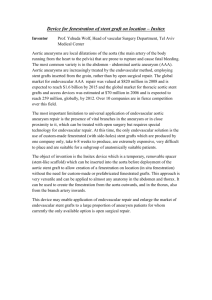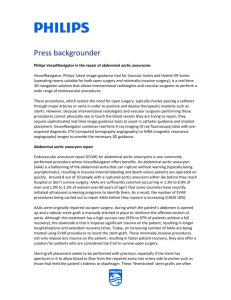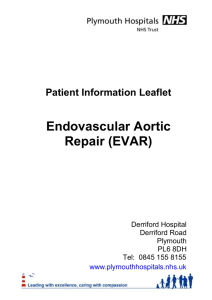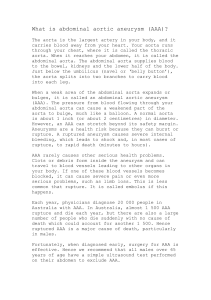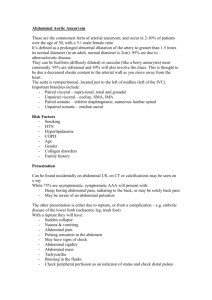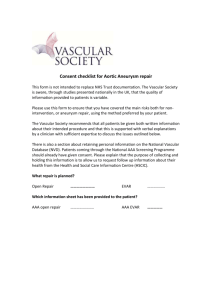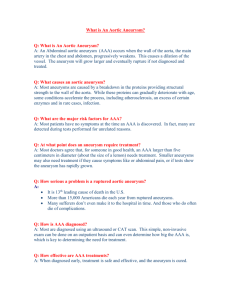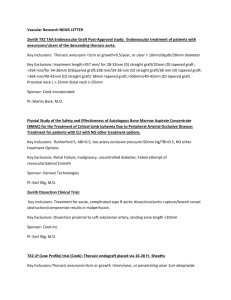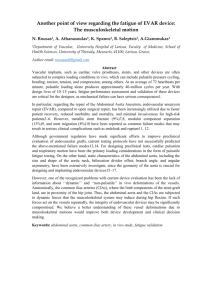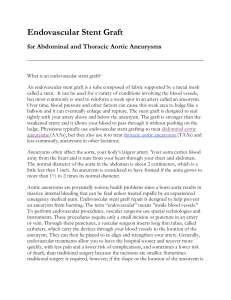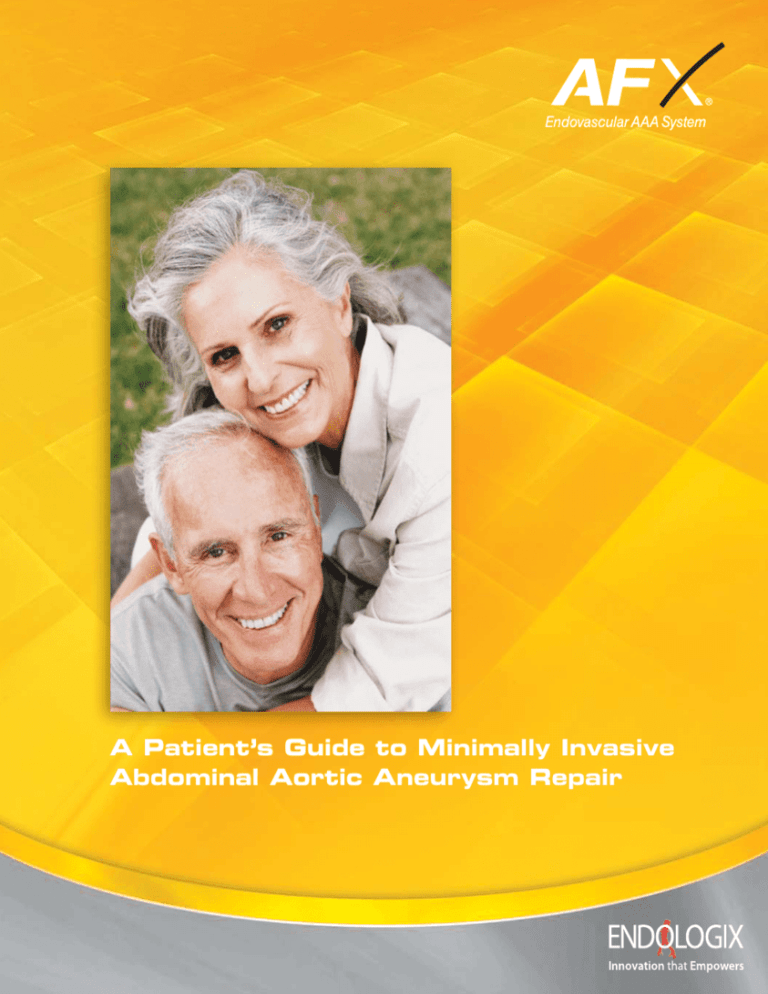
A Patient’s Guide to Minimally Invasive
Abdominal Aortic Aneurysm Repair
Table of Contents
The AFX® Endovascular AAA System . . . . . . . . . . . . . . . . . . . . . . . . . . . . . . . . . . . . . . . . . . . . 1
What is an Abdominal Aortic Aneurysm (AAA)?. . . . . . . . . . . . . . . . . . . . . . . . . . . . . . . . . . . . 2
What Causes an AAA? . . . . . . . . . . . . . . . . . . . . . . . . . . . . . . . . . . . . . . . . . . . . . . . . . . . . . . 2
What are the Symptoms of AAA? . . . . . . . . . . . . . . . . . . . . . . . . . . . . . . . . . . . . . . . . . . . . . . 2
Is This a Serious Condition? . . . . . . . . . . . . . . . . . . . . . . . . . . . . . . . . . . . . . . . . . . . . . . . . . . 3
AAA Diagnosis and Screening . . . . . . . . . . . . . . . . . . . . . . . . . . . . . . . . . . . . . . . . . . . . . . . . . . 3
The Screening Abdominal Aortic Aneurysms Very Efficiently Act (SAAAVE). . . . . . . . . . . . . . 3
Treatment of Abdominal Aortic Aneurysm (AAA). . . . . . . . . . . . . . . . . . . . . . . . . . . . . . . . . . . 3
Medical Management. . . . . . . . . . . . . . . . . . . . . . . . . . . . . . . . . . . . . . . . . . . . . . . . . . . . . . . . . 4
Open Surgical Repair. . . . . . . . . . . . . . . . . . . . . . . . . . . . . . . . . . . . . . . . . . . . . . . . . . . . . . . 4
Endovascular Repair: Traditional EVAR and PEVAR. . . . . . . . . . . . . . . . . . . . . . . . . . . . . . . . . 5
What are the Advantages and Disadvantages of the Different Treatment Options?
Open Surgical Repair. . . . . . . . . . . . . . . . . . . . . . . . . . . . . . . . . . . . . . . . . . . . . . . . . . . . . . . 5
EVAR and PEVAR . . . . . . . . . . . . . . . . . . . . . . . . . . . . . . . . . . . . . . . . . . . . . . . . . . . . . . . . . . 6
The AFX Endovascular AAA System. . . . . . . . . . . . . . . . . . . . . . . . . . . . . . . . . . . . . . . . . . . . . . 6
How is AFX Implanted? . . . . . . . . . . . . . . . . . . . . . . . . . . . . . . . . . . . . . . . . . . . . . . . . . . . . . 6
What Should I Expect After the Endovascular Procedure?. . . . . . . . . . . . . . . . . . . . . . . . . . . . 8
Why is Follow-up Important?. . . . . . . . . . . . . . . . . . . . . . . . . . . . . . . . . . . . . . . . . . . . . . . . . . . 8
When Should I Call My Doctor?. . . . . . . . . . . . . . . . . . . . . . . . . . . . . . . . . . . . . . . . . . . . . . . . . 9
What Do I Do With My Patient Implant Card?. . . . . . . . . . . . . . . . . . . . . . . . . . . . . . . . . . . . . . 9
What if I Need Magnetic Resonance Imaging (MRI)?. . . . . . . . . . . . . . . . . . . . . . . . . . . . . . . . 9
Definition of Medical Terms. . . . . . . . . . . . . . . . . . . . . . . . . . . . . . . . . . . . . . . . . . . . . . . . . . . 10
Where Can I Get More Information? . . . . . . . . . . . . . . . . . . . . . . . . . . . . . . . . . . . . . . . . . . . . 12
Questions for My Doctor. . . . . . . . . . . . . . . . . . . . . . . . . . . . . . . . . . . . . . . . . . . . . . . . . . . . . . 13
The AFX® Endovascular AAA System
This Patient’s Guide has been provided to you on behalf of Endologix, Incorporated. The goal
of this Guide is to help you learn more about your abdominal aortic aneurysm (AAA). You will
learn about the symptoms of abdominal aortic aneurysms, how they are diagnosed, how
they are treated with the AFX System, and what to expect after your surgery.
As with any surgery, the best source of information and advice is your doctor. After
reading this Guide, you may have questions to ask your doctor – page 13 provides space
for you to write your questions. This Guide also provides definitions for medical terms
indicated in bold throughout the Guide – refer to pages 10 and 11 for definitions of
terms, as well as page 12 for additional information resources.
1
What is an Abdominal Aortic
Aneurysm (AAA)?
The aorta is the largest blood vessel in your
body. It carries blood from your heart to the
rest of your body. The aorta extends from the
chest to the abdomen, where it branches into
the iliac arteries. The iliac arteries carry
blood to the lower parts of the body and to the
legs. An abdominal aortic aneurysm
(AAA) occurs when the portion of the aorta
passing through the abdomen bulges because
of a weakening of the vessel wall. The walls
become thin and lose their ability to stretch.
The weakened sections of the wall may
become unable to support the flow of blood
through it and can burst. When an aneurysm
bursts, it causes serious internal bleeding.
What Causes an AAA?
The condition is fairly common in older adults
and is more common in men than in women.
Risk factors for developing it are age, smoking,
family history of AAA, atherosclerotic disease,
and high blood pressure.
What are the Symptoms of AAA?
Most patients diagnosed with AAA have no
symptoms. However, for those patients that do
have symptoms, the most common one is pain
in the abdomen, back, or chest. The pain may
range from mild to severe. In some patients,
the pain in their abdomen spreads to their
back. Others feel the aneurysm as a throbbing
mass in their abdomen.
The AAA is often found during
an examination for an unrelated
health condition. During the
examination, the patient may
feel tenderness, back pain,
abdomen pain, or pain in their
legs. Your doctor may feel a
bulge or throbbing in your
abdomen.
Normal Aorta
Aorta with Large
Abdominal Aneurysm
2
If you have been diagnosed with
an AAA and you develop back
pain, abdomen pain, muscle
pain, weakness in the legs,
or dizziness, call your doctor
immediately, or go to the
closest emergency room.
Is This a Serious Condition?
In the early stages, when the AAA is small in
size, it may not be an immediate health risk to
you. However, your doctor will want to check
your condition on a regular basis to see if your
AAA is growing.
In later stages, if the AAA continues to grow, it
needs to be treated in order to prevent it from
bursting and causing serious internal bleeding.
The risk of an aneurysm bursting increases
as the aneurysm grows in size, and with high
blood pressure. Aneurysms that burst are
very serious and may be fatal.
CT Scan
3D Reconstruction
The Screening Abdominal Aortic
Aneurysms Very Efficiently Act
(SAAAVE) was signed into law on
February 8, 2006 in the United States. The
Act will provide one-time abdominal aortic
aneurysm (AAA) screening for men who have
smoked some time in their life and men or
women who have a family history of the
disease. Screening will be provided as part
of the Welcome to Medicare physical and
coverage begins on January 1, 2007.
AAA Diagnosis and Screening
If you have been diagnosed in the early stages
with a small aneurysm, your doctor will
recommend periodic examinations. Your doctor
may also recommend regular screening if you
have risk factors for developing an aneurysm
(family history of AAA, high blood pressure,
smoking and heart disease).
Treatment of Abdominal Aortic
Aneurysm (AAA)
The goal of all AAA treatment is to prevent the
aneurysm from bursting. The size and location
of the aneurysm within your body, as well as
your general health, will determine how your
doctor treats it.
This screening is commonly done with medical
tests such as CT scan, angiography,
and ultrasound. These tests can confirm
the presence of the AAA and can determine its
location, shape, size, and if it is in an early or
late stage.
3
Medical Management
If your aneurysm is small, your doctor may only
recommend regular examinations to monitor
the size of the aneurysm.
A large aneurysm, or one
that is rapidly growing,
poses a risk of bursting
and requires treatment.
aneurysm section with a fabric tube called a
graft. The graft is sewn into place with sutures
and acts as a replacement blood vessel. This
procedure requires stopping of the flow of
blood through the aorta while the graft is
being sewn in place. The surgery is performed
under general anesthesia and takes about 2 to
4 hours to complete. Patients will usually stay
overnight in the intensive care unit and another
5 to 7 days in the hospital. Depending on how
your body heals, the overall recovery time may
take up to 3 months or longer.
There are two options available for the
treatment of abdominal aortic aneurysms:
Open Surgical Repair and
Endovascular Repair (EVAR),
which includes traditional EVAR and
Percutaneous Endovascular
Repair (PEVAR)
Open Surgical Repair is a well known surgical
procedure that works. However, it involves
major surgery and is not well tolerated by all
patients, depending on their overall health
conditions. Additionally, Open Surgical Repair
has a long recovery period, and with a risk
that you may not return to full function after
the recovery period. As with any medical
procedure, Open Surgical Repair has a risk for
Open Surgical Repair
In Open Surgical Repair, the doctor makes a
cut in the abdomen or side of the patient and
repairs the section of the aorta that has an
aneurysm. The repair is done by replacing the
Open Surgical Repair
Traditional EVAR
4
Percutaneous EVAR
complications. Ask your doctor about the risks
of Open Surgical Repair as they relate to your
own health conditions.
closure device sutures are tied to close the
puncture site through which the stent graft
was delivered.
Endovascular Repair: Traditional EVAR
and PEVAR
A minimally invasive alternative to Open
Surgical Repair, Endovascular Repair (EVAR)
includes traditional EVAR and Percutaneous
Endovascular Repair (PEVAR). With traditional
EVAR, instead of making a large cut in the
abdomen, the doctor makes a small cut in
each groin to gain access to the femoral
arteries (blood vessels).
Not every patient is a candidate for
EVAR or
PEVAR. As with any surgical procedure, EVAR
and PEVAR have a risk of complications. Open
Surgical Repair and Endovascular Repair both
have advantages and disadvantages based
upon each patient’s health condition and
needs. Ask your doctor
about the possible risks
of Endovascular Repair as they relate to your
own health conditions.
What are the Advantages and
Disadvantages of the Different
Treatment Options?
Open Surgical Repair Advantages
• Standard method of treatment
• Well-proven surgical procedure
• Lasting results
• Long-term follow-up examinations
of patient generally not required
An endovascular stent graft is inserted
through the small cut in the leg and placed
inside the aneurysm in the aorta. Blood then
flows through the endovascular stent graft
rather than the weakened aneurysm part of
the aorta. The endovascular stent graft (the
AFX graft) remains inside the aorta permanently.
The EVAR procedure may be done under local
anesthesia and takes about 1 to 3 hours to
complete. Patients will usually have a hospital
stay of only a few days. Depending on how
your body heals, the overall recovery time is
usually 4 to 6 weeks.
Open Surgical Repair Disadvantages
General anesthesia required
• Major abdominal surgery/long abdominal cut
• Surgical complication rate is higher than Endovascular Repair
• Longer hospital stay and recovery
time than Endovascular Repair
•
In PEVAR, the doctor makes a small puncture
incision across the skin in each groin.
Approved suture-based closure devices are
delivered across the skin before the stent graft
is inserted. After the aneurysm is repaired, the
5
EVAR and PEVAR Advantages
• Minimally invasive procedure
• Local anesthesia may be used
• Small cut in one groin, small puncture in the other groin for EVAR, or two small
punctures in groin for PEVAR
• Lower surgical complication rate than Open Surgical Repair
• Shorter hospital stay and shorter recovery than Open Surgical Repair
EVAR and PEVAR Disadvantages
• Higher potential for endoleak or aneurysm bursting than with Open Surgical Repair
• Long-term follow-up examinations are required
• Possibility of additional endovascular or surgical procedures.
How is AFX Implanted?
The entire AFX graft is compressed into a long,
thin plastic tube called a delivery catheter.
Depending upon the procedure, your doctor will
insert thin wires into your femoral arteries
through a small cut (EVAR) in one groin (see
Figure A) and a small puncture in the other
groin, or just two small punctures (PEVAR).
The AFX®
Endovascular AAA System
Your doctor has chosen the Endologix AFX
System to perform your Endovascular Repair
procedure. AFX is a stent graft made in
one-piece, with a main body and two
limbs. AFX is also made of a fabric tube
(called the graft) which is made of ePTFE, a
Teflon® type of material. It is called a stent
graft because it has a metallic structure which
is made of a cobalt chromium alloy that is
attached inside the graft for full support.
The delivery catheter is inserted and advanced
over the wire into position in your aorta (see
Figure B). The stent graft is placed into position
within your body so that the main body of
the stent graft is positioned in the aneurysm
of the aorta, with the two limbs of the stent
graft extending from the aorta into the iliac
arteries. When the main body and limbs
of the stent graft are in proper position, the
6
Figure A
Figure B
stent portion of the stent graft is allowed
to expand (see Figure C). This expansion of
the stent graft holds it in place within your
aorta. The wire and delivery catheter are then
withdrawn from the body. The stent graft
reinforces the aorta that is weakened by the
aneurysm and blood flows through the device
to the arteries that go to the legs.
Figure C
the aneurysm and to select the proper size of
the stent graft to fit your body. At the end of the
procedure, your doctor will confirm the correct
position of the stent graft and the prevention
of blood flow to the aneurysm using X-ray
angiography before closing the cut in your leg
with a few sutures.
As always, X-ray types of imaging, CT
scans, and angiograms carry potential
risks of either radiation exposure, or allergic
reactions related to the contrast dye used
during the tests. The occurrence of an allergic
reaction to the contrast dye is a rare condition.
The benefits of these tests in viewing your
abdominal aortic aneurysm far outweigh the
risk posed by the test. Speak with your doctor
about any concerns you may have about the
follow-up tests.
The doctor uses a visualization method during
this process known as fluoroscopy (real
time X-ray images) viewed on a monitor in
order to place the stent graft in the proper
position within your body.
Before the Endovascular Repair procedure,
your doctor will use diagnostic measurements
(CT scan, angiography, and/or
ultrasound) of your aorta to visualize
7
What Should I Expect After the
Endovascular Procedure?
Endovascular Repair may result in less
discomfort, shorter procedure times
and hospital stays and faster recovery
in
comparison to Open Surgical Repair. Your
hospital stay may be only a few days. You
may be able to return to your normal activities
within 4 to
6 weeks after the procedure and
Endovascular Repair requires regular follow-up
examinations by your doctor.
Why is Follow-up Important?
There are some problems associated with
Endovascular Repair which cannot be felt.
The most serious of these would be continued
aneurysm growth. This is why your regular
follow-up examinations are so important.
Below is a list of problems that could lead to
continued aneurysm growth:
Endoleak - occurs when blood from the
aorta continues to leak into the abdominal
aneurysm. Most endoleaks cannot be felt
and do not require treatment. However, an
endoleak may lead to aneurysm growth and
should be carefully followed over time. A small
number of endoleaks require further treatment.
The PEVAR option of the Endovascular Repair
is even less invasive than traditional EVAR.
8
Graft movement - this is when the
position of the stent graft after placement in
your body shifts over time. You cannot feel
when the graft moves, however it can be seen
with a CT scan.
Aneurysm bursting (rupture) - a very serious
condition that results in internal bleeding.
Symptoms are:
• Dizziness
• Fainting
• Rapid heartbeat
• Sudden weakness
Your doctor will order regular follow-up
examinations with medical tests such as a
physical exam, CT scan, angiography,
and/or ultrasound to view the results of your
treatment and any changes that may occur
over time. It is important that you go to all of
the follow-up examinations recommended by
your doctor. These examinations are generally
required at one month, six months, one year,
and yearly thereafter following your AAA
procedure. Your doctor may require additional
follow-up tests based on the findings at the
regular follow-up visits.
Stent Graft Blockage - symptoms are:
Pain in the legs or hip during walking
• Discoloration or coolness in the leg
•
What Do I Do with my
Patient Implant Card?
If you receive an AFX stent graft, you will receive
an AFX Card. Keep this card handy at all times.
The card provides valuable information on:
• The type of device implanted
• The date of your implantation
• Your doctor’s name and phone number
• MRI information
• Recommended follow-up
When Should I Call My Doctor?
Although most of the problems associated with
Endovascular Repair cannot be felt, call your
doctor immediately if you experience any of
the following symptoms, or go to the closest
emergency room. The following symptoms
are the most common potential problems as
a result of your Endovascular Repair:
Tell all of your healthcare providers that you have
a stent graft and show them your AFX Card.
What if I Need Magnetic
Resonance Imaging (MRI)?
Following implantation with the stent graft,
it is still safe for you to have most MRI
procedures. MRI safety information is
provided on your AFX Card. Be sure to tell all
of your healthcare providers that you have a
stent graft and show them your AFX Card.
Aneurysm growth - symptoms are:
Pain in the legs, back, chest or abdomen
• Numbness in the legs, back, chest,
or abdomen
• Weakness in the legs, back, chest,
or abdomen
•
9
Burst - a tear in the vessel wall that allows
blood to spill into the abdominal cavity
resulting in serious internal bleeding. This
type of tear may occur in the location of the
ballooning of an aneurysm.
Contrast Dye - a drug that is injected into
the blood system to show blood flow through
the blood vessels under X-ray types of imaging
or CT scan.
CT Scan (Computed Tomography
Scan) - an imaging technique that creates
a series of computerized x-rays that form a
picture of your aneurysm. Also known as a
“CAT scan.”
Definition of Medical Terms
Abdominal Aortic Aneurysm (AAA) a ballooning (enlarging or thinning) that occurs
in the part of the aorta that passes through the
abdomen (stomach area). The ballooning is due
to a weakening in the arterial wall.
Delivery Catheter - a long, thin tubelike device, that the doctor uses in delivering
and positioning the stent graft during the
Endovascular Repair procedure.
Endoleak - blood flow into the abdominal
aortic aneurysm after placement of a stent graft.
Aneurysm - a ballooning (enlargement of the
vessel diameter and/or thinning of the vessel
wall) of a weakened area of a blood vessel.
Endovascular Stent Graft - a stent
graft placed within a diseased vessel to
repair an aneurysm without the use of
Open Surgical Repair.
Angiography/Angiogram - angiography
is an X-ray method that uses contrast (dye)
injected into the bloodstream to see blood flow
through blood vessels. The resulting image is
an angiogram.
Endovascular Repair (EVAR) - involves
the placement of an endovascular stent graft
to seal off an aneurysm and create a new
blood flow path. It is considered to be a less
invasive approach than Open Surgical Repair.
Aorta - the main artery that carries blood from
the heart to the rest of the body.
10
Femoral Arteries - two blood vessels
(one in each leg) that carry blood to the thigh
region. Doctors can use the femoral arteries as
a path to reach the iliac arteries and the aorta
during Endovascular Repair.
Percutaneous Endovascular Repair
(PEVAR) - involves the placement of an
endovascular stent graft via small skin
punctures, to seal off an aneurysm and create
a new blood flow path. PEVAR is considered to
be a less invasive approach than Open Surgical
Repair, as well as
standard Endovascular Repair,
which requires larger incisions.
Fluoroscopy - a real time X-ray image that
is viewed on a monitor. The doctor generally
uses fluoroscopy to visualize the placement
of the endovascular stent graft during an
Endovascular Repair procedure.
Stent - metal part of the stent graft that
provides internal support and holds the stent
graft in place.
Iliac Arteries - two large blood vessels
(called femoral arteries), in each leg which
connect to the lower end of the aorta.
Stent Graft - a type of endovascular graft
with a metallic stent inside the internal
structure of the graft fabric cover.
Limb - the two smaller parts of the stent graft
that are placed inside the iliac arteries.
Stent Graft Blockage - when the limbs
of the stent graft become blocked and limit
the amount of blood that can flow through the
stent graft. This is an undesirable condition
that may be felt as pain, weakness, or
numbness in the legs.
Main Body - the largest part of the stent
graft that is placed inside the aorta.
MRI (Magnetic Resonance Imaging) an imaging technique that uses magnetic fields
and radio waves to form detailed images of
structures within the body.
Ultrasound - an imaging technique used
in follow-up of Endovascular Repair that
creates an image through the use of highfrequency sound waves.
Open Surgical Repair - A type of surgery
performed to repair an aneurysm. To reach the
aneurysm, a doctor makes a large cut through
the abdomen of the patient. The doctor repairs
the aorta by replacing the aneurysm section
with a fabric tube called a “graft.” The “graft”
is sewn into place and acts as a replacement
blood vessel.
11
Where Can I Get More
Information?
Aneurysms
Background Information on Abdominal Aortic
Aneurysms.
in Bethesda, Maryland is the world’s largest
medical library. The library collects materials
in all areas of biomedicine and health care,
as well as works on biomedical aspects of
technology, the humanities, and the physical,
life and social sciences.
VascularWeb Patient Information
Website: www.vascularweb.org
VascularWeb is a World Wide Web (WWW)
based global resource of information and
service for individuals interested in improving
vascular health worldwide. VascularWeb
is sponsored and owned by the American
Association for Vascular Surgery (AAVS) and
the Society for Vascular Surgery (SVS), both
non-profit organizations.
Product Information
US Department of Health and
Human Services
Food and Drug Administration
Website: www.fda.gov
A US government agency intended to promote
and protect the public health by helping safe
and effective products reach the market in
a timely way, and monitoring products for
continued safety after they are in use.
Interventional Therapy
Society of Interventional Radiology
Website: www.sirweb.org
The Society of Interventional Radiology (SIR)
is a professional society for doctors who
specialize in interventional or minimally
invasive procedures. SIR is a non-profit,
national organization deeply committed to its
mission to improve health and the quality of
life through the practice of cardiovascular and
interventional radiology.
Contact Information
Endologix, Incorporated
Telephone: (800) 983-2284
Website: www.endologix.com
Endologix Inc., located in Irvine, California,
is engaged in the development of minimally
invasive therapies for the treatment of
aortic aneurysms.
U.S. National Library of Medicine
Website: www.medlineplus.gov
The National Library of Medicine (NLM), on
the campus of the National Institutes of Health
12
Questions for My Doctor
This part of the Guide is provided for you to list any questions that you may have for your
doctor. Your doctor is your best source of information and can help you evaluate your
treatment options based on your own physical health conditions and needs. You may also
want to use this space to keep a record of your discussions with your doctor.
13
Endologix
11 Studebaker
Irvine, CA 92618
Tel 949.595.7200
www.endologix.com
Customer Service
Tel 800.983.2284
Fax 877.843.1500
customerservice@endologix.com
Prior to use, refer to the “Instructions for Use” for complete
and specific indications, contraindications, all warnings, and
precautions. Rx only.
Endologix and AFX are registered trademarks of Endologix, Inc. Teflon® is a registered
trademark of E. I. du Pont de Nemours and Company or its affiliates. All other trademarks
are the property of their respective owners.
© 2013, Endologix, Inc. All rights reserved. C00786 Rev C

